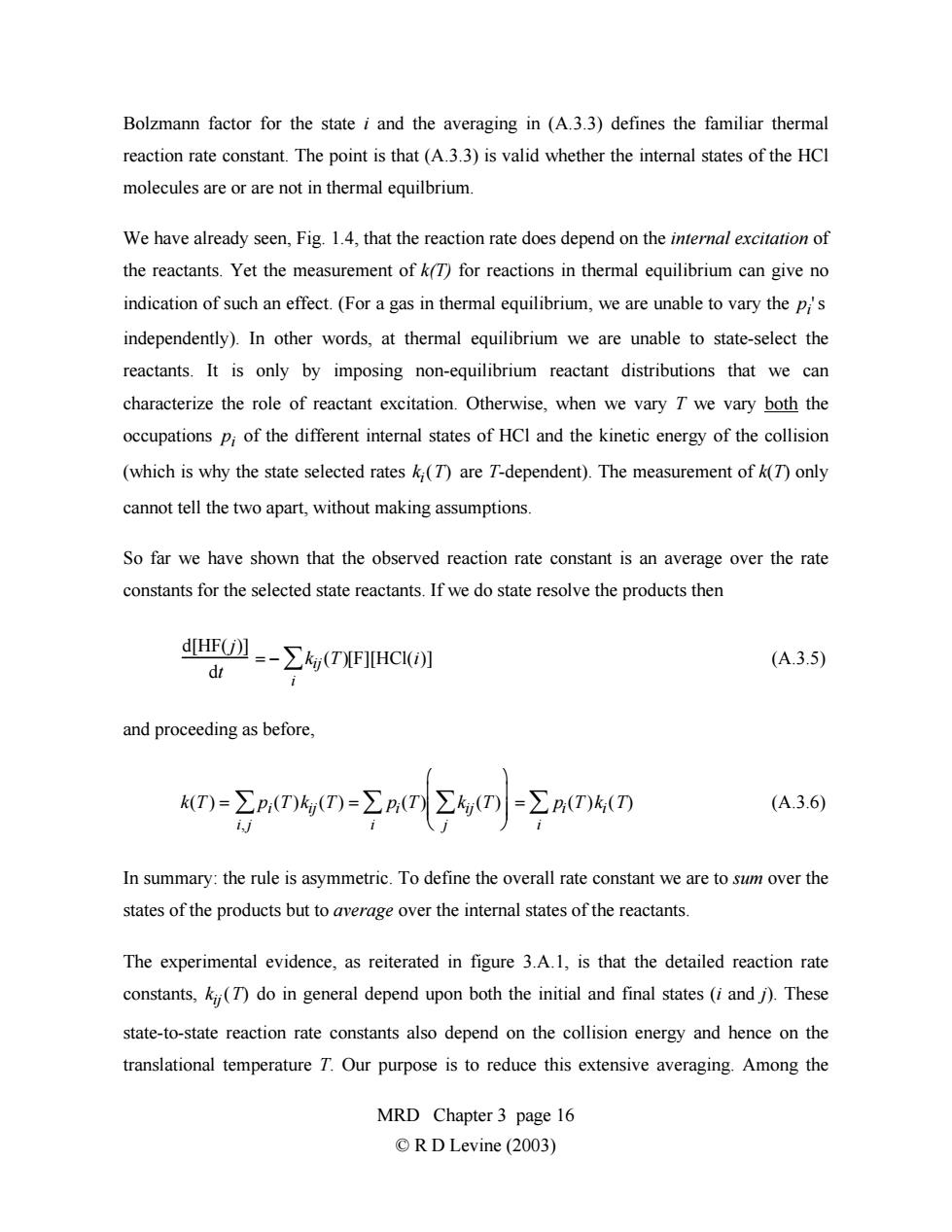正在加载图片...

Bolzmann factor for the state i and the averaging in (A.3.3)defines the familiar thermal reaction rate constant.The point is that(A.3.3)is valid whether the internal states of the HCI molecules are or are not in thermal equilbrium. We have already seen,Fig.1.4,that the reaction rate does depend on the internal excitation of the reactants.Yet the measurement of k(T)for reactions in thermal equilibrium can give no indication of such an effect.(For a gas in thermal equilibrium,we are unable to vary the pi's independently).In other words,at thermal equilibrium we are unable to state-select the reactants.It is only by imposing non-equilibrium reactant distributions that we can characterize the role of reactant excitation.Otherwise,when we vary T we vary both the occupations pi of the different internal states of HCI and the kinetic energy of the collision (which is why the state selected rates ki(T)are T-dependent).The measurement of k(T)only cannot tell the two apart,without making assumptions. So far we have shown that the observed reaction rate constant is an average over the rate constants for the selected state reactants.If we do state resolve the products then =-∑TFHC(】 (A.3.5) dt and proceeding as before, -amn-na网-ΣAmn (A.3.6) i,l In summary:the rule is asymmetric.To define the overall rate constant we are to sum over the states of the products but to average over the internal states of the reactants. The experimental evidence,as reiterated in figure 3.A.1,is that the detailed reaction rate constants,k(T)do in general depend upon both the initial and final states (i and )These state-to-state reaction rate constants also depend on the collision energy and hence on the translational temperature T.Our purpose is to reduce this extensive averaging.Among the MRD Chapter 3 page 16 ©R D Levine(2003)Bolzmann factor for the state i and the averaging in (A.3.3) defines the familiar thermal reaction rate constant. The point is that (A.3.3) is valid whether the internal states of the HCl molecules are or are not in thermal equilbrium. We have already seen, Fig. 1.4, that the reaction rate does depend on the internal excitation of the reactants. Yet the measurement of k(T) for reactions in thermal equilibrium can give no indication of such an effect. (For a gas in thermal equilibrium, we are unable to vary the pi' s independently). In other words, at thermal equilibrium we are unable to state-select the reactants. It is only by imposing non-equilibrium reactant distributions that we can characterize the role of reactant excitation. Otherwise, when we vary T we vary both the occupations pi of the different internal states of HCl and the kinetic energy of the collision (which is why the state selected rates ki(T) are T-dependent). The measurement of k(T) only cannot tell the two apart, without making assumptions. So far we have shown that the observed reaction rate constant is an average over the rate constants for the selected state reactants. If we do state resolve the products then d[HF(j)] dt = − kij(T)[F][HCl(i)] i ∑ (A.3.5) and proceeding as before, k(T) = pi i, j ∑ (T)kij(T) = pi i ∑ (T) kij j ∑ (T) = pi i ∑ (T)ki(T) (A.3.6) In summary: the rule is asymmetric. To define the overall rate constant we are to sum over the states of the products but to average over the internal states of the reactants. The experimental evidence, as reiterated in figure 3.A.1, is that the detailed reaction rate constants, kij(T) do in general depend upon both the initial and final states (i and j). These state-to-state reaction rate constants also depend on the collision energy and hence on the translational temperature T. Our purpose is to reduce this extensive averaging. Among the MRD Chapter 3 page 16 © R D Levine (2003)